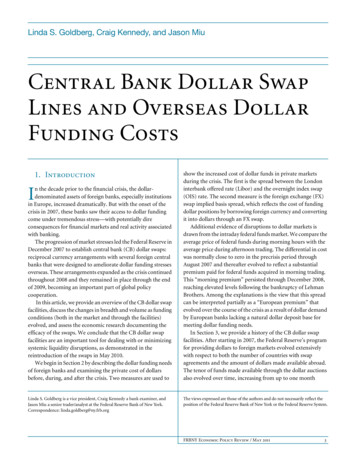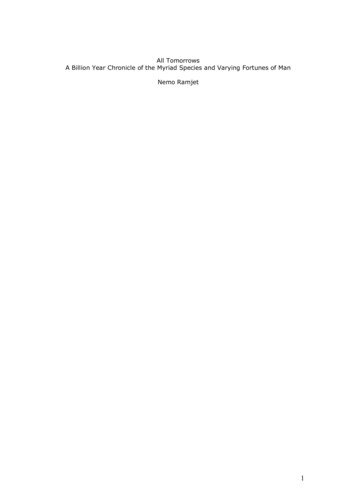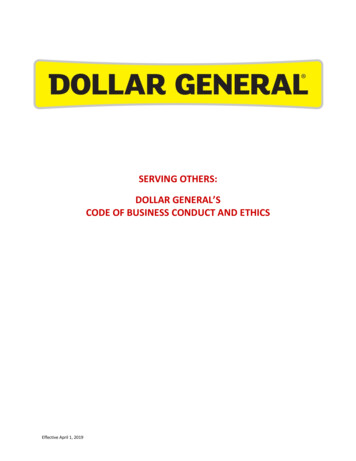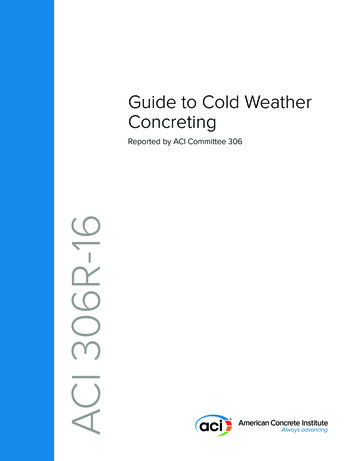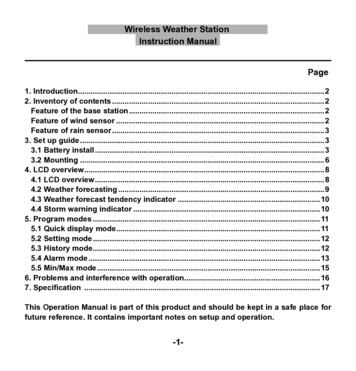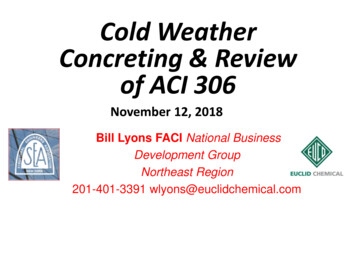
Transcription
U.S. Billion-Dollar Weather &Climate Disasters 1980-2021https://www.ncdc.noaa.gov/billions/The U.S. has sustained 310 weather and climate disasters since 1980 in which overall damages/costsreached or exceeded 1 billion. Values in parentheses represent the 2021 Consumer Price Index costadjusted value (if different than original value). The total cost of these 310 events exceeds 2.155 trillion.DroughtFloodingFreezeSevere StormTropical Cyclone202120 EventsWestern WildfiresWildfireWildfireWinter Storm 141.0B ( 145.0B) 688 Deaths 10.4B ( 10.6B)8 Deaths2021: Severe drought conditions and periods of extreme heat provided conditions favorable for another damaging western wildfireseason most focused across California, Colorado, Oregon, Washington, Idaho, Montana and Arizona. The Dixie Fire consumed over960,000 acres making it the second-largest wildfire on record in California while also destroying more than 1,000 structures.California's Caldor Fire grew rapidly during August, threatening South Lake Tahoe communities and burned over 220,000 acres.Other large wildfires included the Ford Corkscrew Fire (Washington), the Bootleg Fire (Oregon), the Boundary Fire (Idaho), the TrailCreek Fire (Montana) and the Telegraph Fire (Arizona), among many others. There was also the Marshall Fire in Boulder County,Colorado on December 30 that damaged or destroyed more than 1,000 homes and businesses. This wildfire is the most destructiveon record in Colorado. Throughout the wildfire season air quality was also a concern across numerous states, as ash and fineparticulates from wildfires obscured the skies and made outdoor activities more hazardous. Over 7.1 million acres burned nationallyduring the 2021 wildfire season.Western Drought and Heat WaveDrought 8.4B ( 8.9B)229 Deaths2021: Western drought conditions were persistent throughout 2021, as the drought expanded and intensified across many Westernstates. A historic heat wave also developed for many days across the Pacific Northwest shattering numerous all-time hightemperature records across the region. This prolonged heat dome was maximized over the states of Oregon and Washington andextended well into Canada. These extreme temperatures impacted several major cities and millions of people. For example, Portlandreached a high of 116 degrees F while Seattle reached 108 degrees F. These extreme temperatures caused hundreds of direct andindirect heat-related fatalities across Oregon and Washington, not including excess mortality that may be hundreds of additionaldeaths. This combined drought and heat rapidly dried out vegetation across the West, impacting agriculture. Low water levels alsoforced the hydroelectric power plant at Lake Oroville in California to shut down for the first time since it opened in 1967.Midwest Derecho and Tornado OutbreakSevere Storm 1.8B1 DeathDecember 2021: A rare, record-breaking December derecho and tornado outbreak caused widespread damage that was focusedacross Kansas, Nebraska, Iowa, Minnesota and Wisconsin. There were many reports of hurricane-force thunderstorm wind gusts andmore than 50 tornadoes causing widespread damage to homes, vehicles, businesses and infrastructure. This was the first Decemberderecho on record to occur within the United States. This event also produced the first December tornado on record in Minnesotasince 1950, with 17 tornadoes reported across southeast Minnesota.Southeast, Central Tornado OutbreakSevere Storm 3.9B93 DeathsDecember 2021: Historic December tornado outbreak across several southeast and central states caused devastating damageacross many towns and cities. This outbreak produced two long-tracked EF-4 tornadoes across Arkansas, Missouri, Tennessee andKentucky. The longest tornado track was nearly 166 miles across Kentucky and a small portion of Tennessee. This was thelongest-tracked tornado on record in Kentucky and was a U.S. record tornado track length for the month of December. There wereover 800 total miles of tornado path length on December 10. The peak intensity from this outbreak was EF-4 rated wind speeds of190 mph in Mayfield, Kentucky. This day was also the deadliest December tornado outbreak recorded in the United States surpassingthe Vicksburg, Mississippi tornado of December 5, 1953, which caused 38 fatalities.Hurricane NicholasTropical Cyclone 1.0B0 DeathsSeptember 2021: Category 1 Hurricane Nicholas made landfall near Sargent Beach, Texas on September 14 and moved slowlytoward Louisiana over the next several days. This slow progression helped to produce flooding rainfall across regions of the GulfCoast that were already saturated from Hurricane Ida.Hurricane IdaTropical Cyclone 73.6B ( 75.0B)96 fPage 1
August 2021: Category 4 Hurricane Ida made landfall near Port Fourchon, Louisiana with maximum sustained winds of 150 mph(240km/h) and a minimum central pressure of 930 mb. Ida was one of three hurricanes in recorded history to make landfall inLouisiana with 150 mph winds, along with Hurricane Laura in 2020 and the 'Last Island' hurricane of 1856. Grand Isle, Louisiana tooka direct hit with 100% of its homes damaged and nearly 40% were nearly-to-completely destroyed. There was heavy damage to theenergy infrastructure across southern Louisiana causing widespread, long duration power outages to millions of people. Parts of NewOrleans were without power for nearly a week due to the widespread damage. As the remnants of Ida moved into the Northeast itmerged with a frontal system creating severe weather and flash flooding across a wide region from eastern Pennsylvania to NewYork. Flash flood emergencies were declared in New Jersey and New York for the first time, producing damage to homes,businesses, vehicles and infrastructure while also causing dozens of fatalities.Tropical Storm FredTropical Cyclone 1.3B7 DeathsAugust 2021: Tropical Storm Fred made landfall near Panama City, Florida. As Fred progressed northward it caused torrentialflooding across the southern Appalachian Mountains with more than a foot of rainfall reported in some locations of western NorthCarolina. This flash flooding caused damage to many homes, businesses, vehicles, roads and bridges, in additional to severalfatalities. Fred also produced nearly a dozen tornadoes across the Northeast as it moved up the East Coast.North Central Severe WeatherSevere Storm 1.3B2 DeathsAugust 2021: Widespread high wind impacts across numerous North Central states including Illinois, Michigan, Wisconsin, Indiana,Ohio and Missouri. This multi-day event caused damage to infrastructure, homes, vehicles and businesses.Central Severe StormsSevere Storm 1.1B0 DeathsJuly 2021: Severe storms caused considerable hail damage across numerous Central states including Missouri, Nebraska, Iowa,South Dakota, North Dakota, New Mexico and Texas. There was also widespread high wind damage to homes, vehicles andbusinesses in many other surrounding states.Tropical Storm ElsaTropical Cyclone 1.2B1 DeathJuly 2021: Tropical Storm Elsa made landfall in Taylor County, Florida producing heavy rain, wind, flooding and tornadoes in portionsof Florida, Georgia and the Carolinas, as well as flooding across parts of the Northeast. Southern New England and New York's LongIsland experienced flash flooding, leading to impassable roads, stranded vehicles and disruption. Elsa was the earliest fifth-namedstorm on record.Central Severe StormsSevere Storm 1.3B0 DeathsJune 2021: A combination of thunderstorm high winds, hail and tornadoes affected numerous Central states. The states most affectedincluded Michigan, Illinois, Indiana, Ohio, Missouri, Kansas and Texas with damage to homes, businesses, vehicles and agriculture.Ohio Valley Hail StormsSevere Storm 1.7B0 DeathsJune 2021: Damaging hail storm and high wind impacts across several states including Ohio, Illinois, Indiana, Michigan, Wisconsin,Minnesota, Iowa and Missouri. The hail impacts were most severe in southeastern Minnesota, southern Iowa, southeastern Indianaand southwestern Ohio, with damage to many homes, vehicles and businesses.Louisiana FloodingFlooding 1.3B ( 1.4B)5 DeathsMay 2021: Torrential rainfall from thunderstorms across Louisiana and coastal Texas caused widespread flooding and resulted inhundreds of water rescues. Baton Rouge and Lake Charles experienced flood damage to thousands of homes, vehicles andbusinesses, as more than 12 inches of rain fell. Lake Charles also continues to recover from the widespread damage caused byHurricanes Laura and Delta less than 9 months before this flood event.Southern Tornadoes and Southeast Severe WeatherSevere Storm 1.3B4 DeathsMay 2021: Tornadoes and severe storms with widespread high wind and large hail cause damage across many Southern andSoutheastern states including Mississippi, Texas, Arkansas, Alabama, Georgia, South Carolina, North Carolina, and Tennessee.There were over 111 confirmed tornadoes largely clustered in central Mississippi and surrounding states.Texas and Oklahoma Severe WeatherSevere Storm 3.1B ( 3.3B)0 DeathsApril 2021: Severe weather including tornadoes, high wind, localized flooding and large hail cause widespread impacts across centralTexas and Oklahoma. There was considerable damage across Texas and Oklahoma to many homes, vehicles and businessesparticularly from hail storms. Several of the more impacted areas include west of San Antonio, north of Fort Worth, and southwest ofSan Marcos.Texas Hail StormsSevere Storm 1.5B0 fPage 2
April 2021: A series of hail storms impacted central Texas causing damage to many homes, vehicles and businesses. There wasconsiderable hail damage northeast of Austin, west of Georgetown and southwest of The Woodlands.Eastern Severe WeatherSevere Storm 1.3B ( 1.4B)8 DeathsMarch 2021: Severe weather producing hail, high wind and more than two dozen tornadoes impacted numerous states includingArkansas, Alabama, Georgia, Mississippi, South Carolina, North Carolina and Virginia. Tennessee was also affected with significantflooding in Nashville and surrounding areas that damaged businesses, homes and vehicles. There were also many high wind damagereports across Pennsylvania, Maryland and New Jersey.Southeast Tornadoes and Severe WeatherSevere Storm 1.7B ( 1.8B)6 DeathsMarch 2021: At least 41 tornadoes impact several states including Kentucky, Tennessee, Mississippi, Alabama and Georgia. Theseincluded one EF-4, four EF-3s, ten EF-2s and approximately two-dozen EF-1 or EF-0 tornadoes. The strongest of these tornadoeswere focused across central Alabama and western Georgia with tracks across the entire width of Alabama. There was widespreaddamage to homes, businesses, vehicles and infrastructure.Northwest, Central, Eastern Winter Storm and Cold WaveWinter Storm 22.7B ( 24.0B)226 DeathsFebruary 2021: Historic cold wave and winter storm impacts many northwest, central and eastern states. Temperature departuresexceeding 40.0 degrees F (22.2 degrees C) below normal occurred from Nebraska southward to Texas. The prolonged arctic aircaused widespread power outages in Texas, as well as other southern states, with multiple days of sustained below-freezingtemperatures. At the peak of the outage, nearly 10 million people were without power. Additional impacts were frozen water pipes,which burst upon thawing causing water damage to buildings. These extreme conditions also caused or contributed to the direct andindirect deaths of more than 210 people in Texas alone. This count does not include excess mortality that may be hundreds ofadditional deaths. There were also snow and ice impacts across numerous states including Oklahoma, Arkansas, Missouri, Illinois,Kentucky, Tennessee, Louisiana, Mississippi, Colorado, Oregon and Washington. This is now the costliest U.S. winter storm event onrecord, more than doubling the inflation-adjusted cost of the 'Storm of the Century' that occurred in March 1993.California Flooding and Severe WeatherFlooding 1.1B ( 1.2B)2 DeathsJanuary 2021: California was impacted by an atmospheric river in late-January, in which more than 7 inches of rain fell from southernCalifornia to the central California coast. Rainfall totals exceeded 15 inches in Monterey and San Luis Obispo counties. These heavyrains caused flooding and mudslides in some of the same areas burned by wildfires in late-2020. This combination caused dozens ofslides and debris flows damaging homes, vehicles and businesses and infrastructure. Highway 1 south of Big Sur was washed outwhile the Sierra Nevada range received several feet of snow, closing major highways. In addition to significant rain and snow, highwinds also caused extensive power outages across parts the region.202022 EventsWestern Wildfires - California, Oregon, Washington FirestormsWildfire 95.3B ( 102.0B) 16.5B ( 17.6B)262 Deaths46 DeathsFall 2020: A record-breaking U.S. wildfire season burned more than 10.2 million acres. California more than doubled its previousannual record for area burned (last set in 2018) with over 4.1 million acres. Five of the top six largest wildfires on record in California(dating to 1932) burned during August and September. The August Complex was the largest California wildfire, which began as 37separate wildfires within the Mendocino National Forest, set off after storms caused 10,000 lightning strikes across NorthernCalifornia. Approximately 10,500 structures were damaged or destroyed across California. Oregon also had historic levels of wildfiredamage, as over 2,000 structures burned. These wildfires spread rapidly and destroyed several small towns in California, Oregon andWashington. Colorado also had a severe wildfire season, as its three largest wildfires on record burned during 2020. Dense wildfiresmoke also produced hazardous air quality that affected millions of people that also included major cities for weeks. Hundreds ofadditional wildfires also burned across other Western states.Western/Central Drought and Heat WaveDrought 4.5B ( 4.8B)45 DeathsSummer-Fall 2020: Widespread, continuous drought and record heat affected more than a dozen Western and Central states formuch of the summer, fall and into the winter months. Persistent above-average temperatures and precipitation deficits caused D3(extreme) and D4 (exceptional) drought coverage in December that was the largest extent since August 2012. Death Valley recordeda temperature of 130 degrees F - the highest measured temperature globally in decades - while Los Angeles county recorded arecord high of 121 degrees F. There were considerable crop and livestock impacts across the West and Central states from both thepersistent heat and increasingly dry conditions. The combined drought and heat also assisted in drying out vegetation across theWest that contributed to the Western wildfire potential and severity.Tropical Storm EtaTropical Cyclone 1.5B ( 1.6B)12 DeathsNovember 2020: Tropical Storm Eta made landfall in the Florida Keys on November 8 followed by a second landfall near Cedar ge 3
on the west coast of Florida on November 10. Eta produced wind and heavy rain impacts in southern Florida. These impactscontinued well inland, as Eta's energy merged with a cold front across several eastern states. This combination produced extremerainfall across North Carolina and Virginia, which led to significant flooding that damaged homes, businesses and infrastructure. Thisflooding also caused one dozen fatalities.Hurricane ZetaTropical Cyclone 4.4B ( 4.7B)6 DeathsOctober 2020: Hurricane Zeta was a category 2 hurricane that made landfall at Cocodrie, Louisiana with maximum sustained winds of110 mph on October 28th. Zeta's path inland saw an acceleration of its quick landfall speed to nearly 40 mph, which allowed the windfields to maintain some strength. These wind impacts propagated well inland affecting parts of Louisiana, Alabama, Mississippi,northern Georgia and into the Carolinas. Hurricane Zeta was the fifth tropical cyclone to make landfall in Louisiana during 2020 aspart of a historically active Atlantic hurricane season.Hurricane DeltaTropical Cyclone 2.9B ( 3.1B)5 DeathsOctober 2020: Hurricane Delta was a category 2 hurricane that made landfall near Creole, Louisiana with winds of 100 mph onOctober 9. This was nearly the same location in which category 4 Hurricane Laura made landfall 6 weeks prior. Heavy rainfall, highwinds, storm surge, and nearly one dozen EF-0 or EF-1 tornadoes caused damage across several states including Louisiana, easternTexas, Mississippi and Georgia.Hurricane SallyTropical Cyclone 7.3B ( 7.8B)5 DeathsSeptember 2020: Hurricane Sally was a category 2 hurricane at landfall in Gulf Shores, Alabama. Wind gusts up to 100 mph and20-30 inches of rainfall caused considerable flood and wind damage across Alabama, the Florida panhandle and into Georgia. Manyhomes and businesses in downtown Pensacola, FL were impacted from flooding produced by storm surge and heavy rainfall. 2020 isnow the fourth consecutive year (2017-2020) that the U.S. has been impacted by a slow moving tropical cyclone that producedextreme rainfall and damaging floods - Harvey, Florence, Imelda and Sally.Hurricane LauraTropical Cyclone 19.0B ( 20.3B)42 DeathsAugust 2020: Hurricane Laura was a powerful category 4 that made landfall at Cameron Parish, in southwestern Louisiana on August27. Winds up to 150 mph and storm surge in excess of 15 feet caused heavy damage along the coast and inland to the city of LakeCharles. Many broken water systems and a severely damaged electrical grid in southern Louisiana will slow the recovery process.Laura was the strongest hurricane (by maximum sustained windspeed at landfall) to hit Louisiana since the 1856 Last Islandhurricane. Laura also had highest landfall wind speed to impact the U.S. since Hurricane Michael in 2018. There were additionalimpacts to surrounding states including Texas, Mississippi and Arkansas.Central Severe Weather - DerechoSevere Storm 11.0B ( 11.8B)4 DeathsAugust 2020: A powerful derecho traveled from southeast South Dakota to Ohio, a path of 770 miles in 14 hours producingwidespread winds greater than 100 mph. The states most affected included Iowa, Illinois, Minnesota, Indiana and Ohio. This derechocaused widespread damage to millions of acres of corn and soybean crops across central Iowa. There was also severe damage tohomes, businesses and vehicles particularly in Cedar Rapids, Iowa. In addition, there were 15 tornadoes across northeastern Illinoisseveral affecting the Chicago metropolitan area. This is the third severe weather event (since 1980) with inflation-adjusted costs over 10.0 ( 10.7) billion joining the late-April and May 2011 tornado outbreaks across the Southeastern and Central states, respectively.Hurricane IsaiasTropical Cyclone 4.8B ( 5.1B)16 DeathsAugust 2020: Hurricane Isaias made landfall in southeastern North Carolina as a category 1 storm. Isaias accelerated up the EastCoast, resulting in widespread damage and power outages across New York, New Jersey and Pennsylvania. There was alsoconsiderable inland flooding most notably in Pennsylvania. In addition, 34 tornadoes developed across North Carolina, Virginia,Maryland, Delaware and New Jersey due to Isaias. Many tornadoes were weaker (EF-0 and EF-1) producing scattered damage toagriculture, structures and residences. Isaias also produced several EF-2 tornadoes and one EF-3 tornado that caused damage incoastal North Carolina and Virginia.Hurricane HannaTropical Cyclone 1.1B ( 1.2B)0 DeathsJuly 2020: Category 1 Hurricane Hanna made landfall at Padre Island, Texas on July 25 with sustained winds of 90 miles per hour.The impacts from wind, wave action and flooding were most notable in damaging coastal infrastructure and to the agriculture sector.The crop damage was most focused across the Rio Grande Valley in southern Texas.Central Severe WeatherSevere Storm 1.2B ( 1.3B)0 DeathsJuly 2020: Central severe weather producing hundreds of severe hail and high wind reports across numerous states includingNebraska, South Dakota, Minnesota, Kansas, Oklahoma, Iowa, Illinois and Indiana. These storms caused impacts to many homes,vehicles and ts.pdfPage 4
South Texas Hail StormsSevere Storm 1.4B ( 1.5B)0 DeathsMay 2020: South Texas hail storms cause widespread impact to several cities with golf-ball sized hail damaging many homes,vehicles and businesses. The highest concentration of hail damage occurred across the northern portion of the San Antoniometroplex. There was also significant damage east of San Marcos, southeast of Waco and to the west and south of Bryan andCollege Station.South, Central and Eastern Severe WeatherSevere Storm 1.6B ( 1.7B)2 DeathsMay 2020: A combination of thunderstorm high winds, hail and tornadoes affected numerous Southern, Central and Eastern states.The states most affected included Texas, Illinois and North Carolina with damage to homes, businesses and vehicles. Oklahoma,Arkansas, Indiana, Tennessee, Alabama, Georgia, Florida and South Carolina.Central and Eastern Severe WeatherSevere Storm 2.1B ( 2.3B)2 DeathsMay 2020: Severe weather across several Central and Eastern states including Kansas, Missouri, Arkansas, Tennessee and SouthCarolina. High wind and hail damage was notably clustered across southern Missouri and western to central Tennessee, which werethe states with the highest damage totals for the event.Central, Southern and Eastern Severe WeatherSevere Storm 1.0B ( 1.1B)1 DeathApril 2020: Severe weather across many Central, Southern and Eastern states produced primarily large hail and high winds thatcaused widespread damage to many homes, vehicles and businesses. The states affected included Oklahoma, Texas, Missouri,Arkansas, Louisiana, Virginia, Pennsylvania, Maryland, Delaware and New Jersey.Southern Severe WeatherSevere Storm 1.4B ( 1.5B)3 DeathsApril 2020: Severe weather caused damage across many Southern states. The states most affected from a combination of highwinds, hail and tornadoes included Texas, Oklahoma, Louisiana, Mississippi, Alabama, Georgia, Florida and Virginia. The states withthe highest damage totals for the event were Oklahoma, Louisiana and Texas.Southeast and Eastern Tornado OutbreakSevere Storm 3.4B ( 3.7B)35 DeathsApril 2020: Outbreak of at least 140 tornadoes from Texas to Maryland including 3 EF4s, 12 EF3s, 20 EF2s, 77 EF1s and 28 EF0s.Damage was extensive and highly destructive to many homes, vehicles and businesses across more than a dozen Southeast andEastern states.North Central and Ohio Valley Hail Storms and Severe WeatherSevere Storm 2.9B ( 3.1B)0 DeathsApril 2020: Numerous hail storms caused widespread damage across many North Central and Ohio Valley states including Illinois,Iowa, Indiana, Ohio, Michigan, Wisconsin and Missouri. More than 20 tornadoes were also reorted across southern Indiana and Ohio.There was additional widespread high wind damage to homes, vehicles and businesses in many other surrounding states.Midwest and Ohio Valley Severe WeatherSevere Storm 2.6B ( 2.8B)0 DeathsMarch 2020: Severe weather caused damage across many Midwest and Ohio Valley states including Missouri, Oklahoma, Texas,Illinois, Indiana, Ohio, Arkansas, Kentucky, Tennessee, West Virginia and Pennsylvania. The states most affected from a combinationof high winds and hail were Missouri, Ohio and Arkansas. There were also two dozen tornadoes across Iowa, Illinois, Indiana andArkansas causing additional damage.Tennessee Tornadoes and Southeast Severe WeatherSevere Storm 2.3B ( 2.5B)25 DeathsMarch 2020: Powerful EF-3 and EF-4 tornadoes cause considerable damage across the Nashville metroplex and several countieseast of Nashville. This damage included many homes, businesses, vehicles, 90 planes and numerous buildings at the Nashvilleairport. There was also additional hail and wind damage in the surrounding states including Alabama, Kentucky, Mississippi andMissouri.South, East and Northeast Severe WeatherSevere Storm 1.3B3 DeathsFebruary 2020: Severe weather across many South, East and Northeastern states including AL, FL, GA, SC, LA, MS, TN, NC, VA,PA, RI, NY, NJ, MD and MA. There were more than 20 tornadoes clustered across central Mississippi into Tennessee. There werealso hundreds of high wind damage reports from Florida to New Jersey, with the Carolinas and Florida receiving the most costlydamage.Southeast Tornadoes and Northern Storms and FloodingSevere Storm 1.1B ( 1.2B)10 DeathsJanuary 2020: More than 80 tornadoes and severe storms caused damage across many southeastern states (AL, AR, GA, IL, IN, KY,LA, MS, MO, NC, OH, SC, TN, TX, VA, WI). Storms and severe flooding also impacted northern states including Michigan, Wisconsinand New York. Significant damage occurred along the shoreline of Lake Michigan to roads, the foundation of homes and to age 5
Milwaukee. These powerful waves were generated by high winds and a lack of seasonal ice cover.201914 EventsCalifornia and Alaska WildfiresWildfire 44.7B ( 48.9B) 4.5B ( 4.9B)44 Deaths3 DeathsSummer-Fall 2019: California experienced a damaging wildfire season in 2019, largely resulting from the Kincade and Saddle Ridgewildfires. In addition, a key California electrical utility provider turned off power to millions of homes and businesses several timesduring days with forecasted high winds and extremely dry conditions. This step was designed to minimize wildfires, with somesuccess, but it also caused billions of dollars in losses to those affected. Alaska also suffered a near-historic wildfire season with morethan 2.5 million acres burned. These wildfire conditions were primed due to Alaska's record-breaking heat and dry conditions duringthe summer months. July 2019 was the warmest month ever recorded in Alaska.Texas Tornadoes and Central Severe WeatherSevere Storm 1.7B ( 1.9B)2 DeathsOctober 2019: Numerous tornadoes caused widespread damage across northern Dallas damaging thousands of homes, vehicles,businesses and other public infrastructure. Tornadoes up to EF-3 intensity with maximum winds of 140 mph tracked across a largesection of highly developed northern Dallas. Additionally high winds and hail damage also caused damage in other states includingOklahoma, Missouri, Arkansas, Louisiana and Tennessee.Tropical Storm ImeldaTropical Cyclone 5.0B ( 5.4B)5 DeathsSeptember 2019: Tropical storm and its remnants cause 24 to 36 inches of rainfall over a 3-day period across a large area betweenHouston and Beaumont, Texas. The largest storm total, 43.39 inches, was reported at North Fork Taylors Bayou, Texas. Manythousands of homes, cars and businesses were impacted by flood water due to this extraordinarily heavy rainfall. Imelda is yetanother of the historically extreme rainfall and flood events that have become a regular occurrence across Southeast Texas over thelast 5 years.Hurricane DorianTropical Cyclone 1.6B ( 1.7B)10 DeathsSeptember 2019: Category 1 hurricane makes landfall on the Outer Banks of North Carolina, after devastating the northern BahamaIslands as a historically-powerful and slow-moving hurricane. Dorian tracked offshore parallel to the Florida, Georgia and SouthCarolina coastline before making a North Carolina landfall, bringing a destructive sound-side surge that inundated many coastalproperties and isolated residents who did not evacuate. Significant flood, severe storm, and tornado damage to many homes andbusinesses occurred on the Outer Banks of North Carolina. Dorian's intensification to a category 5 storm marks the fourth consecutiveyear, in which a maximum category 5 storm developed in the Atlantic basin - a new record. Dorian also tied the record for maximumsustained wind speed for a landfalling hurricane (185 mph) in the Atlantic, a record shared with the historic 1935 Labor DayHurricane.Mississippi River, Midwest and Southern FloodingFlooding 6.2B ( 6.7B)4 DeathsJuly 2019: Additional major flooding impacted many Southern Plains states significantly affecting agriculture, roads, bridges, levees,dams and other assets across many cities and towns. The states most affected were Oklahoma, Nebraska, Missouri, Illinois, Kansas,Arkansas, Kentucky, Tennessee, Texas, Mississippi and Louisiana. Very high water levels also disrupted barge traffic along theMississippi River, which negatively impacted a variety of dependent industries. Indiana and Ohio were also affected by persistentheavy rainfall that flooded farmland, which prevented and reduced crop planting by millions of acres.Colorado Hail StormsSevere Storm 1.0B ( 1.1B)0 DeathsJuly 2019: Colorado hail storms across the Denver and Fort Collins that damaged many homes and vehicles.Arkansas River FloodingFlooding 3.0B ( 3.3B)5 DeathsJune 2019: Historic flooding impacts the Arkansas River Basin with damage to homes, agriculture, roads, bridges and levees focusedacross eastern Oklahoma and western Arkansas. Thousands of homes, cars and businesses were flooded due a combination of highrivers, levee failure and persistently heavy rainfall from May 20 through June.Rockies, Central and Northeast Tornadoes and Severe WeatherSevere Storm 4.5B ( 4.9B)3 DeathsMay 2019: A four-day tornado outbreak impacts many states across the Rockies, Central and Northeast (CO, WY, NE, KS, OK, MO,IA, IL, IN, OH, PA and NJ). This outbreak produced 190 tornadoes in addition to hundreds of reports of damaging hail andstraight-line thunderstorm winds. Of particular note was an EF-4 tornado that produced heavy damage near the city of Dayton, Ohioon May 27.Central Severe WeatherSevere Storm 1.0B ( 1.1B)0 fPage 6
May 2019: Central severe storms across the Illinois, Indiana, Iowa and Texas damaged many homes, businesses and vehicles.South and Southeast Severe Wea
The Dixie Fire consumed over 960,000 acres making it the second-largest wildfire on record in California while also destroying more than 1,000 structures. California's Caldor Fire grew rapidly during August, threatening So

